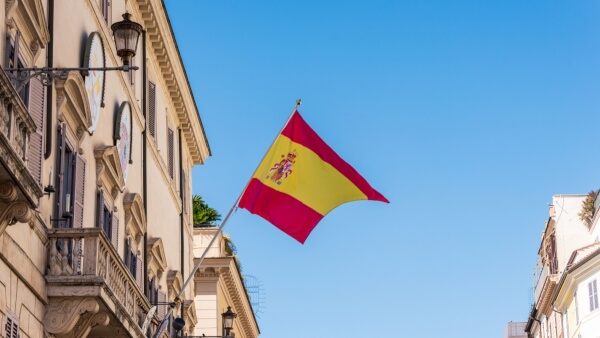Getting a Spanish work visa as an American: Step-by-step guide
Wondering how to get a Spanish work visa? Take a look at our overview to learn about the necessary steps, documents, and processes for Americans.

Imagine stepping off the plane in Spain and being able to open a bank account, sign a lease, and set up your mobile phone without delay. The key to making that happen is your NIE—Número de Identidad de Extranjero. This personal ID number is required for most official tasks in Spain, from renting a flat to paying taxes.
If you’re an American planning to live, work, study, or invest in Spain, getting your NIE early will save you time and stress. This guide walks you through the NIE process clearly and simply so you can get set up confidently.
We'll also introduce Wise — your international money transfer alternative. Use Wise to send stress-free transfers to over 140 countries - all at the standard mid-market exchange rate.
| Table of contents |
|---|
| An NIE—Número de Identidad de Extranjero—is a personal identification number assigned to non-Spanish residents. Think of it as your all-access pass to life in Spain. To buy property, open a bank account, pay taxes, start a business, or even connect utilities, you’ll need this number. |
|---|
The NIE is issued by Spain’s Guardia Civil or Policía Nacional. It’s linked to your full name rather than your passport number, making it a consistent identifier even if you renew or change your passport later.
There are two main forms of the NIE:
| 💡 Note: Not all NIE holders get a TIE, as it depends on your visa or residence status. |
|---|
The NIE is not a visa, and it doesn’t give you permission to live or work in Spain. But you’ll need it before you can do almost anything official, so applying early is a smart move.
Your NIE isn’t optional—it’s required for:
- Opening bank or mobile accounts
- Signing leases and utility contracts
- Enrolling in school or university
- Buying or selling property
- Paying taxes
- Working, freelancing, or registering a business
- Registering with healthcare or social services
If you plan to stay longer than 90 days, the NIE is often one of the first documents officials will ask for.¹
If you're still in the U.S., you can apply for your NIE through a Spanish consulate before heading to Spain. Here’s how to do it step by step.
Each U.S. consulate covers specific states. For example, Washington DC serves the DMV region, and San Francisco covers parts of California. Double-check your jurisdiction and appointment requirements.
You’ll need:
The U.S. fee is $10 USD, paid as instructed by the consulate as cash via a money order or cashier’s check.²
Attend your appointment (or walk in during designated hours) with all documents and copies. If using a representative, include a notarized Power of Attorney and their ID.
Processing takes approximately two weeks, though delays can happen. Once ready, you’ll receive an email or letter with your number. You will need to keep this printed document safe.³
Banks are certainly one option for sending money internationally, as are services like PayPal. But the problem with banks is they can often be slow, expensive and inconvenient. Luckily, there’s a better alternative out there.
You can send money worldwide with Wise for low fees and the mid-market exchange rate. It’s easy and quick to set up a payment online, and you’re guaranteed secure transfers even when sending large sums.
Wise is a money service business (MSB) regulated by 12 international financial authorities and uses sophisticated security features to keep you and your money safe.
Open a Wise account, and you can send, spend and convert between 40+ currencies whenever you need to. You can even receive money from all over the world using your own local account details.
As if all that wasn’t enough, there’s a Wise Multi-Currency Card too. For a one-time fee of just $9, you can spend in over 150 countries in the local currency. Your USD is automatically converted at the mid-market rate for just a small conversion fee.
While the NIE (Número de Identidad de Extranjero) is a single identification number, how you receive it and what it's tied to can vary depending on your purpose in Spain. Here are the main types and how they’re typically issued.
If you're applying from outside Spain, for example, through a Spanish consulate in the U.S., you'll usually receive a non-resident NIE. This is issued on a white A4 paper certificate and is most commonly used for:
| This version does not grant you residency or the right to stay long term. It's purely for administrative use. |
|---|
If you're moving to Spain for work, study, family reunification, or long-term living, your NIE will be issued alongside your residency permit. In this case, you’ll receive a TIE (Tarjeta de Identidad de Extranjero), which is a biometric residency card that contains your NIE number, photo, and type of stay.
This card acts as both your foreigner ID and proof of your legal residence in Spain.
In some cases, authorities may issue a temporary NIE while your long-term permit is being processed. This can allow you to start certain processes like opening a bank account or enrolling in services, while awaiting your full documentation.
No matter which version you get, your NIE number never changes. It stays with you for life, even if your reason for staying in Spain does.
How long it takes to get your NIE depends on where and how you apply. Americans have two main options: applying through a Spanish consulate in the U.S. or applying in person once in Spain. Here's what to expect.
If you apply through a Spanish consulate in the United States, the process typically takes 15 to 45 days from the time your application is accepted.
However, this timeline can vary depending on:
Some consulates may process NIE requests faster if you apply in person and your paperwork is in order. Mailing applications often takes longer due to back-and-forth postage and internal processing times.
If you apply after you arrive in Spain, the process can move more quickly (usually within 1 to 2 weeks), especially if you’ve booked your appointment (cita previa) in advance. Once you attend your appointment and submit your documents, you may receive:
It’s best to start the NIE application early, especially if you plan to make financial or legal decisions soon after arrival. To avoid delays, make sure all your paperwork is translated, notarized, and apostilled as required.
Got questions about getting your NIE in Spain? Here are the most common ones U.S. citizens ask, along with clear, practical answers to help you navigate the process confidently.
If you apply in Spain, you can typically get your NIE certificate within 1 to 2 weeks after your appointment. In some cases, it's issued the same day. If you're applying for a residency card (TIE), expect 30 to 45 days for printing and collection.⁴
Applying from a Spanish consulate in the U.S. usually takes 15 to 45 days after your documents are received and approved, depending on the consulate's processing times.
The standard government fee for an NIE is around €9 to €12. You’ll need to complete and pay the Modelo 790 Código 012 tax form before your appointment. If using an agent or legal service, expect additional fees.²
No, U.S. citizens must apply in person either at a Spanish consulate or at a police station in Spain. Some third-party agencies can help you book appointments or handle paperwork, but you must appear in person to finalize the process.
Not exactly. The NIE is your foreign ID number. The TIE (Tarjeta de Identidad de Extranjero) is a physical residency card that includes your NIE number, photo, and residency status. You only get a TIE if you're granted legal residency in Spain.
No. Tourists don’t need an NIE. But if you plan to buy property, open a bank account, or engage in any long-term activity, you’ll need one even if you’re not staying permanently.
The number itself never expires, but the certificate or card may. If you’re issued a temporary certificate, some banks or agencies may request a reissue if it’s more than 3 months old. Residency cards (TIEs) have expiration dates and must be renewed accordingly.
Getting your NIE is one of the most important first steps to settling in Spain. It unlocks everything from opening a bank account to registering for healthcare or buying property. While the paperwork may seem intimidating, following the right steps and preparing in advance can make the process smooth and stress-free.
| Send money internationally with Wise to 140+ countries and 40+ currencies – all at the fair mid-market exchange rate with low, transparent fees. |
|---|
Sources
*Please see terms of use and product availability for your region or visit Wise fees and pricing for the most up to date pricing and fee information.
This publication is provided for general information purposes and does not constitute legal, tax or other professional advice from Wise Payments Limited or its subsidiaries and its affiliates, and it is not intended as a substitute for obtaining advice from a financial advisor or any other professional.
We make no representations, warranties or guarantees, whether expressed or implied, that the content in the publication is accurate, complete or up to date.

Wondering how to get a Spanish work visa? Take a look at our overview to learn about the necessary steps, documents, and processes for Americans.

Are you looking for the best property management companies in Spain? Find out all about the top local providers to take care of your home overseas.

If you're a US expat in Spain, check out this guide to know whether you're subject to Spanish taxes and how to fulfill your US reporting obligations.

Everything you need to know about getting a Golden Visa in Spain.

Everything you need to know about getting the digital nomad visa in Spain.

One important decision, if you’re moving to Spain with family, is how to ensure that your children have the best possible education. As an expat family, you...